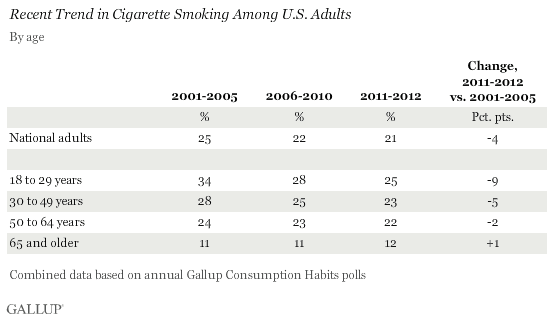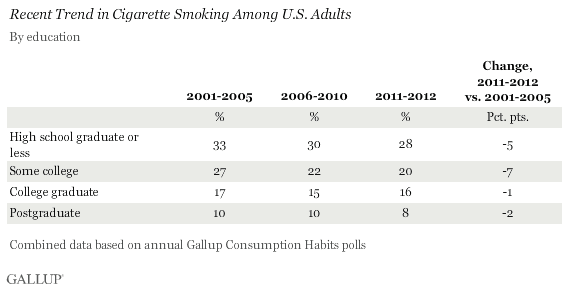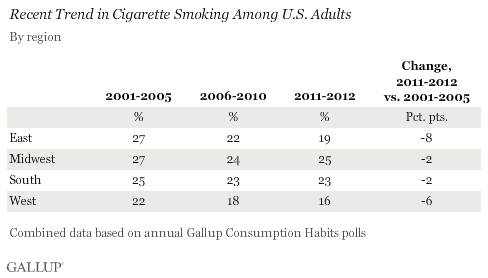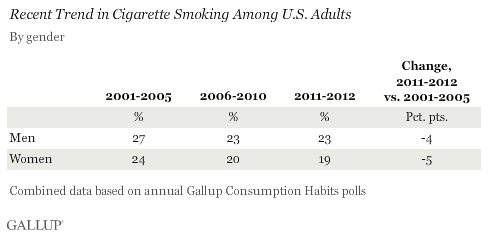PRINCETON, NJ -- The prevalence of smoking in the U.S. is currently tied for the all-time low in Gallup trends dating from 1944, after a long, slow decline in smoking rates since the 1970s. Currently, 20% of adults say they smoked a cigarette "in the past week," down from 22% last year but matching the 2009 level.

Gallup recorded the sharpest decline in smoking between the early 1970s and late 1980s, with the rate dropping roughly 15 percentage points during this period. Smoking leveled off at about 25% for much of the 1990s, but has since descended slowly, if unevenly, to 20%. The latest results are from Gallup's annual Consumption Habits poll, conducted July 9-12, and are in line with the smoking rate the Gallup-Healthways Well-Being Index finds in daily surveys of Americans.
According to an analysis of Gallup trends since 2001 -- combining data from Gallup's Consumption Habits polls into three periods, 2001-2005, 2006-2010, and 2011-2012 -- the most recent decline in smoking has not occurred across the board, but is seen mainly among certain groups. Smoking rates have fallen particularly sharply among young adults -- those 18 to 29 -- as well as among college non-graduates and those living in the East and West.
Smoking Slides The Most Among Young Adults
Since the start of the 2000s, smoking has fallen nine percentage points among 18- to 29-year-olds -- from 34% in 2001-2005 to 25% in 2011-2012. It has declined five points among those 30 to 49, while dipping only slightly among those 50 to 64 and staying about the same among those 65 and older.
As a result of these changes, young adults are now about as likely to smoke as are those aged 30 to 64, whereas earlier in the last decade they exhibited the highest rate of smoking of any age group.

Lower-Educated and Coastal Residents Lighting Up Less
Smoking has long been inversely correlated with education, meaning smoking rates are highest among those with the least formal education and lowest among those with higher education levels. While that pattern continues today, the gap has narrowed due to a sharper decline in smoking among college non-graduates than among college graduates.
Specifically, the smoking rate fell five percentage points among adults with no more than a high school diploma and fell seven points among those with limited college experience, while falling no more than two points among postgraduates and those with undergraduate degrees.

Smoking rates have decreased the most in the Eastern and Western regions of the country, while declining only slightly in the Midwest and South. Throughout this shift, the West has remained the region with the lowest percentage of smokers, now 16%. The East has moved from tied with the Midwest for having the highest rate to being the second lowest.

Fewer men and women are lighting up now than in 2001-2005, with a similar decline seen among both groups. Smoking continues to be slightly more common among men than among women.

Bottom Line
At one time, nearly half of U.S. adults smoked cigarettes, but after smoking rates declined to 25% by the mid-1990s, public policymakers have found it difficult to drive the rate significantly lower. Although smoking among all adults dropped by only four points, from 25% to 21%, between 2001-2005 and 2011-2012, the good news is that the rate of decline is much sharper among adults 18 to 29 than among those 50 and older. This may reflect a decline in smoking among teens and other minors -- the ages at which a lifetime of smoking often starts -- and in any case increases the likelihood that smoking rates will continue to fall in the years ahead.
Survey Methods
Results for this Gallup poll are based on telephone interviews conducted July 9-12, 2012, with a random sample of 1,014 adults, aged 18 and older, living in all 50 U.S. states and the District of Columbia.
For results based on the total sample of national adults, one can say with 95% confidence that the maximum margin of sampling error is ±4 percentage points.
Interviews are conducted with respondents on landline telephones and cellular phones, with interviews conducted in Spanish for respondents who are primarily Spanish-speaking. Each sample includes a minimum quota of 400 cell phone respondents and 600 landline respondents per 1,000 national adults, with additional minimum quotas among landline respondents by region. Landline telephone numbers are chosen at random among listed telephone numbers. Cell phone numbers are selected using random-digit-dial methods. Landline respondents are chosen at random within each household on the basis of which member had the most recent birthday.
Samples are weighted by gender, age, race, Hispanic ethnicity, education, region, adults in the household, and phone status (cell phone only/landline only/both, cell phone mostly, and having an unlisted landline number). Demographic weighting targets are based on the March 2011 Current Population Survey figures for the aged 18 and older non-institutionalized population living in U.S. telephone households. All reported margins of sampling error include the computed design effects for weighting and sample design.
In addition to sampling error, question wording and practical difficulties in conducting surveys can introduce error or bias into the findings of public opinion polls.
View methodology, full question results, and trend data.
For more details on Gallup's polling methodology, visit www.gallup.com.
